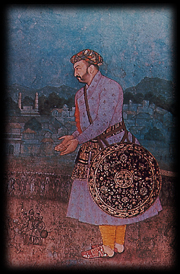
Abdul Hasan Asaf Khan
Encyclopedia

Mumtaz Mahal
Mumtaz Mahal born as Arjumand Banu Begum was a Mughal Empress and chief consort of emperor Shah Jahan...
, who was the wife of the Mughal Emperor Shah Jahan
Shah Jahan
Shah Jahan Shah Jahan (also spelled Shah Jehan, Shahjehan, , Persian: شاه جهان) (January 5, 1592 – January 22, 1666) Shah Jahan (also spelled Shah Jehan, Shahjehan, , Persian: شاه جهان) (January 5, 1592 – January 22, 1666) (Full title: His Imperial Majesty Al-Sultan al-'Azam wal Khaqan...
, the Emperor of India. Asaf Khan was also the elder brother of Mehrunissa, (better known as Nur Jahan), the empress of Shah Jahan's father, Jahangir
Jahangir
Jahangir was the ruler of the Mughal Empire from 1605 until his death. The name Jahangir is from Persian جهانگیر,meaning "Conqueror of the World"...
. Many scholars have been researching on the origins of Asaf Khan's clan. Some researches claim they are descending from Armenia
Armenia
Armenia , officially the Republic of Armenia , is a landlocked mountainous country in the Caucasus region of Eurasia...
, but most likely from Persia. His other daughter Parwar Khanam was married to Mohtashim Khan, the son of jahangir
Jahangir
Jahangir was the ruler of the Mughal Empire from 1605 until his death. The name Jahangir is from Persian جهانگیر,meaning "Conqueror of the World"...
's foster brother Qutubuddin Koka
Qutubuddin Koka
Qutb-ud-Din Khan Kokah was the Mughal subahdar of Bengal Subah during the reign of emperor Jahangir. He was appointed governor of Bengal on 2 September 1606 and died in office on 20 May 1607.-Early life:...
. Her masoleun is located in Sheikhpur, Badaun
Asaf Khan was appointed Governor of Lahore
Lahore
Lahore is the capital of the Pakistani province of Punjab and the second largest city in the country. With a rich and fabulous history dating back to over a thousand years ago, Lahore is no doubt Pakistan's cultural capital. One of the most densely populated cities in the world, Lahore remains a...
by Emperor Jahangir in 1625. After the demise of Jahangir in 1627, he was instrumental in securing the accession of his son-in-law Shah Jahan by colluding with Dawar Bakht (Jahangir's other son) and defeating the rival claimant Prince Shahryar (Nur Jahan's son-in-law, married to her daughter by her previous marriage to Sher Afghan) in a battle near Lahore. Asaf Khan enjoyed a position even more elevated than in the preceding reign and retained it until 1632, when he failed in the siege of Bijapur, from which time he seems to have lost favour.
Asaf Khan died on 12 June 1641 while engaged in fighting against the forces of rebel Raja Jagat Singh
Raja Jagat Singh
Raja Jagat Singh Pathania succeeded Raja Suraj Mal as the King of Nurpur, Himachal/India. He was the second son of Raja Basu Dev. The golden period of Pathania rule on Nurpur came under the reign of Raja Jagat Singh. Under him the state reached her pinnacle...
Pathania
Pathania
Pathania is the name of the branch of the Tomara Clan of Chandravanshi, Rajputs, descended from Lord Arjuna, the hero of Mahabharata. It is one of the ruling Rajput clans of India. They mostly live in and around Himachal Pradesh, in North India...
. His tomb was commissioned to be built in Shahdara tomb complex in Lahore by Shah Jahan. It is built to the west of Jahangir's mausoleum
Tomb of Jahangir
Tomb of Jahangir, is the mausoleum built for the Mughal Emperor Jahangir who ruled from 1605 to 1627. The mausoleum is located near the town of Shahdara Bagh in Lahore, Pakistan. His son Shah Jahan built the mausoleum 10 years after his father's death. It is sited in an attractive walled garden....
, facing it. The tomb is built entirely of brick. It is of octagonal plan, with a large central double-layered bulbous dome. Each side has a deeply recessed iwan, or alcove, with a door and arched window looking into the tomb. Marble, and blue kashi tiles typical of Lahore once covered the mausoleum; they have since been stripped off. The interior was renowned for its lavish use of white marble and precious stone inlay, which had been removed. The inner dome ceiling is decorated in a high plaster relief of interlacing patterns, but much of it has fallen off. The tomb contains the marble sarcophagus, carved with Koranic inscriptions, similar to that in Emperor Jahangir's adjacent tomb.
The historian Hargreaves says about the tomb, "Despite its simplicity, there is a sense of restful quietude at this site (Asaf Khan's Tomb) which renders it one of the most fascinating monuments in the neighbourhood of Lahore."

